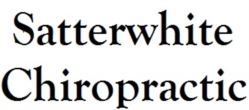Extension of the spine feels good at times, say after hunching over a desk or raking leaves all day. Extension of the spine feels bad at other times. Satterwhite Chiropractic studies the dynamics of extension, the good and the bad. Oxford chiropractic patients present to the office with extension trouble oftentimes and don’t even know it! Satterwhite Chiropractic tests the spine for its reaction to extension and recognizes what’s happening for the patient when the spine reacts the way it does to spinal extension – good or bad – and makes sure a chiropractic treatment plan is set to get the spine feeling well again.

Now in the cervical spine and cervical spine pain patients, Satterwhite Chiropractic notes that extension of the neck shows change to the spine. One study reports that 17% of office workers with neck pain and 27% of those with low back pain developed chronic musculoskeletal pain. These chronic pain patients had these issues in common: high body mass index, high initial pain intensity, high psychological job demands, and frequent neck extension during the work day. (1) In a another study, extension decreased all the foraminal dimensions significantly. Flexion increased all of them significantly. Compression decreased them, too, while traction increased foraminal height but not width as much. (2) So extension and compression in the cervical spine closes the spinal space.
Now in low back pain patients, compression also plays a role in the nutrition of the disc. High-rate loading reduces transport into the disc’s nucleus (center) by 16.8% while low-rate loading increases it by 16.8% in healthy discs and 12.6% in degenerative discs. (3) So interestingly, flexion, traction and gentle, slow motion helps both healthy and degenerative discs, a daily goal of your Oxford chiropractor at Satterwhite Chiropractic
And lastly, low back pain patients show different reactions to tests during the Oxford chiropractic spinal examination. 85% of low back pain patients are diagnosed with “non-specific low back pain” as a diagnosis. (4) Wow! As back pain specialists, chiropractic physicians look closely at low back pain and the patient presenting with it to our offices. Back pain specialists like your Oxford chiropractor are always on the lookout for a new test that can give us more detail and point us in the right direction of a diagnosis to help our chiropractic patients. This test is interesting, the standing back extension test. It indicates motor control impairment. The researchers presented the concept that excessive excursion of the lumbar spine into extension represents the inability of the stabilizers of the spine to control the movement of low back. (5) So what can a low back pain patient do? Strengthen the stabilizers of the low back.
Before starting down the exercise path, contact your Oxford chiropractor at Satterwhite Chiropractic for a thorough clinical examination of your spine and its reaction to extension motion as well as a clear treatment plan to include exercise and nutrition and spinal manipulation to optimally address your cervical spine and lumbar spine conditions and their related pain for a return to the quality of life you want to enjoy.
